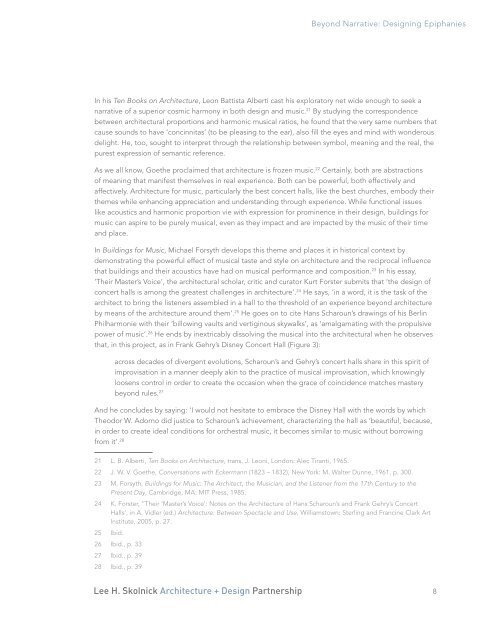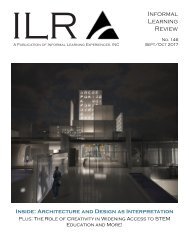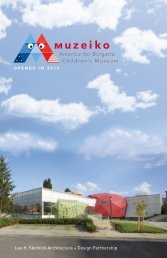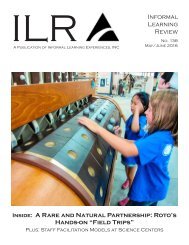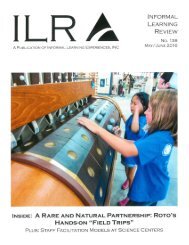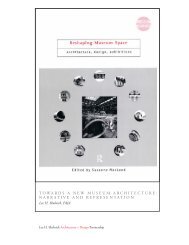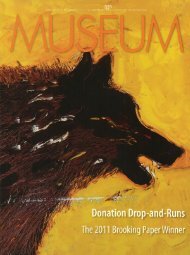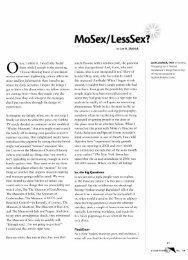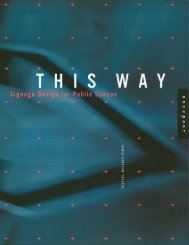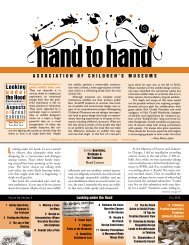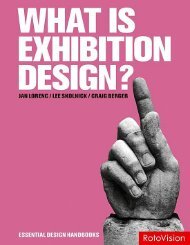Beyond Narrative
- No tags were found...
Create successful ePaper yourself
Turn your PDF publications into a flip-book with our unique Google optimized e-Paper software.
<strong>Beyond</strong> <strong>Narrative</strong>: Designing Epiphanies<br />
In his Ten Books on Architecture, Leon Battista Alberti cast his exploratory net wide enough to seek a<br />
narrative of a superior cosmic harmony in both design and music. 21 By studying the correspondence<br />
between architectural proportions and harmonic musical ratios, he found that the very same numbers that<br />
cause sounds to have ‘concinnitas’ (to be pleasing to the ear), also fill the eyes and mind with wonderous<br />
delight. He, too, sought to interpret through the relationship between symbol, meaning and the real, the<br />
purest expression of semantic reference.<br />
As we all know, Goethe proclaimed that architecture is frozen music. 22 Certainly, both are abstractions<br />
of meaning that manifest themselves in real experience. Both can be powerful, both effectively and<br />
affectively. Architecture for music, particularly the best concert halls, like the best churches, embody their<br />
themes while enhancing appreciation and understanding through experience. While functional issues<br />
like acoustics and harmonic proportion vie with expression for prominence in their design, buildings for<br />
music can aspire to be purely musical, even as they impact and are impacted by the music of their time<br />
and place.<br />
In Buildings for Music, Michael Forsyth develops this theme and places it in historical context by<br />
demonstrating the powerful effect of musical taste and style on architecture and the reciprocal influence<br />
that buildings and their acoustics have had on musical performance and composition. 23 In his essay,<br />
‘Their Master’s Voice’, the architectural scholar, critic and curator Kurt Forster submits that ‘the design of<br />
concert halls is among the greatest challenges in architecture’. 24 He says, ‘in a word, it is the task of the<br />
architect to bring the listeners assembled in a hall to the threshold of an experience beyond architecture<br />
by means of the architecture around them’. 25 He goes on to cite Hans Scharoun’s drawings of his Berlin<br />
Philharmonie with their ‘billowing vaults and vertiginous skywalks’, as ‘amalgamating with the propulsive<br />
power of music’. 26 He ends by inextricably dissolving the musical into the architectural when he observes<br />
that, in this project, as in Frank Gehry’s Disney Concert Hall (Figure 3):<br />
across decades of divergent evolutions, Scharoun’s and Gehry’s concert halls share in this spirit of<br />
improvisation in a manner deeply akin to the practice of musical improvisation, which knowingly<br />
loosens control in order to create the occasion when the grace of coincidence matches mastery<br />
beyond rules. 27<br />
And he concludes by saying: ‘I would not hesitate to embrace the Disney Hall with the words by which<br />
Theodor W. Adorno did justice to Scharoun’s achievement, characterizing the hall as ‘beautiful, because,<br />
in order to create ideal conditions for orchestral music, it becomes similar to music without borrowing<br />
from it’. 28<br />
21 L. B. Alberti, Ten Books on Architecture, trans. J. Leoni, London: Alec Tiranti, 1965.<br />
22 J. W. V. Goethe, Conversations with Eckermann (1823 – 1832), New York: M. Walter Dunne, 1961, p. 300.<br />
23 M. Forsyth, Buildings for Music: The Architect, the Musician, and the Listener from the 17th Century to the<br />
Present Day, Cambridge, MA: MIT Press, 1985.<br />
24 K. Forster, ‘’Their ‘Master’s Voice’: Notes on the Architecture of Hans Scharoun’s and Frank Gehry’s Concert<br />
Halls’, in A. Vidler (ed.) Architecture: Between Spectacle and Use, Williamstown: Sterling and Francine Clark Art<br />
Institute, 2005, p. 27.<br />
25 Ibid.<br />
26 Ibid., p. 33<br />
27 Ibid., p. 39<br />
28 Ibid., p. 39<br />
8


